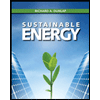
Sustainable Energy, Si Edition
2nd Edition
ISBN: 9781337551670
Author: DUNLAP, Richard A.
Publisher: Cengage Learning
expand_more
expand_more
format_list_bulleted
Concept explainers
Question
Chapter 3, Problem 18P
To determine
Calculate the time at which the LNG last.
Expert Solution & Answer
Trending nowThis is a popular solution!

Students have asked these similar questions
A cantilever beam 12 ft long supports a uniform service superimposed deadload of 1 kip/ft, and a concentrated service live load of 14 kip at the free end. Theconcrete compressive strength is 4 ksi, and the steel yield strength is 60 ksi. Thebeam section at the support is shown. Find the adequacy of the section inresisting bending moment at the support.
u(t)
(Uss)
-1
a/w = 1.0
M
1
2
3
T
please help
Chapter 3 Solutions
Sustainable Energy, Si Edition
Knowledge Booster
Learn more about
Need a deep-dive on the concept behind this application? Look no further. Learn more about this topic, civil-engineering and related others by exploring similar questions and additional content below.Similar questions
- Please use MATLAB with codes and figures.Recreate the following four Figures of the textbook using MATLAB and the appropriate parameters. Comment on your observations for each Figure. List all of the parameters that you have used. The figures are attached belowarrow_forwardA simply supported beam for a building interior with 18 ft span has a cross section of 12 in width and 21 in overall depth. The beam is made with 5 ksi compressive strength concrete and 60 ksi reinforcing steel. The beam supports a uniform service superimposed dead load of 1.6 kip/ft, and a uniform service live load of 80 psf throughout the span. The beams are laterally spaced 20 ft apart c/c. Design this beam and show in a sketch.arrow_forwardThe dam presented below is 180 m long (in the direction perpendicular to the plane of the cross-section). For the water elevations given on the drawing: a) Construct the flow net (minimum number of equipotential lines should be 10), b) Calculate the rate of seepage for the entire dam, c) Find the total uplift force on the dam (ignore barriers), and d) Estimate the hydraulic gradient at points A, B, and D. Recommended to use a spreadsheet to include all equations for calculations of potentials.arrow_forward
- Using A36 steel select the lightest equal leg single angle member to resist a factored (LRFD) tensile load Pu = 167 kips. The member will be connected through one leg with one line of three 3/4-in Ø bolts spaced at 3 in between centers as shown. The edge distances Leh = Lev = 1.5 in. Use LRFD Method Use U from Table D3.1, Case 8. See attached (D3.1 Case 8, Shear Strength of Bolts, Table 1-7 Dimensions of Angles).arrow_forwardThe system in Fig. consists of 1200 m of 5 cm cast-iron pipe e=0.26mm, two 45° and four 90° elbows, a globe valve, and a sharp exit into a reservoir. If the elevation at point 1 is 400 m, what gage pressure is required at point 1 to deliver 0.005 m3/s of water into the reservoir? U= 10-6m² 1 * sec -, K 45° elbows= 0.2, K 90° flanged = 0.2, K globe valve 10, K Sharp exit=1 G Elevation 500 m 45° Open globe 45° Sharp exitarrow_forward: The 6-cm-diameter pipe in Fig. contains glycerin [specific gravity 0.95], flowing at a rate of 6 m³/h. Verify that the flow is laminar. For the pressure measurements shown, is the flow up or down? What is the indicated head loss for these pressures? 3.7 atm B 2.1 atm 12 m Aarrow_forward
- Find the discharge if K entrance =0.1, Kvalve-1, e=0.26mm, U= 1× 10-6m² ? sec 5 m Water at 20°C 6 cm D=5cm, L 2 m Open jet Butterfly valve DC 107 at 30°arrow_forwardWhat level (h) must be maintained in Fig to deliver a flow rate of Q=0.425L/sec in commercial-steel pipe e=0.1mm, U= 1 * 10-6m²/sec? Water at 20°C h L=24m D=120mmarrow_forward17-24. Design a water distribution system for the Village of Waffle (Figure P-17-24). The specific de- sign requirements of the client are as follows: 128 m Figure P-17-24 Village of Waffle. -120 m 120 m Open in new tab 00 N ☐ Pancake Road D Apartments ☐ DD. D ☐ 128 m Coffee Creek DODQ00000 Eggs Road State Road 00000 ㅁㅁㅁㅁㅁㅁ Syrup River _128 m 136 m 120 m ㅁㅁㅁ Syrup River 112 m 104 m 100-Year flood -112 m 120 m- 128 m Water tower Grd El 137 m 100 m Share a. Fire protection to be provided by the water distribution system. b. Minimum water pressure at top of apartment building is to be 240 kPa. c. Maximum system pressure is to be 550 kPa. The following assumptions may be used in the design: a. Each of the four apartment buildings is occupied by 50 residents. Each apartment building is four stories high. Each story is 3 m high. b. Each house is occupied by three residents. c. Average daily demand for the village is 500 Lpcd. d. Peaking factor is 6.2 for peak hour demand. e. Needed fire flow…arrow_forward
- Two group of students are collecting traffic data at the two sections A and B 200 meters apartalong a highway. Group A shows that 5 vehicles pass those sections at interval of 8, 9, 10, 11and 13 sections respectively. If the speeds of the vehicles were 80, 72, 64, 56 and 48 kmph.Compute : (i) the time mean speed (ii) space mean speed, and (b)what will be the averagedensity of the above traffic streamarrow_forwardA person entering public transport center to purchase intercity Bus ticket. There is two ticket line to purchase tickets. Each ticket purchase takes an average of 12 seconds. The average arrival rate is 3 persons/minute. Find (a) Probability of having one traveler in the system, (b) the average length of queue, (c)average waiting time in queue, (d) average time spend in system. Arrival follows Poisson distribution and service time follows negative exponential distribution.arrow_forwardUse recommended referencing style (APA) for all materials you used in the presentation of the report. Question 1 Ivan Institute has secured funds to construct an oval-like lecture hall at their new campus at a cost of 3 million United States Dollars. As a consultant of the project, you have a mandate to package the project for the most qualified contractor. Carry out the procurement process from advertisement to awardarrow_forward
arrow_back_ios
SEE MORE QUESTIONS
arrow_forward_ios
Recommended textbooks for you

 Sustainable EnergyCivil EngineeringISBN:9781133108689Author:Richard A. DunlapPublisher:Cengage Learning
Sustainable EnergyCivil EngineeringISBN:9781133108689Author:Richard A. DunlapPublisher:Cengage Learning Solid Waste EngineeringCivil EngineeringISBN:9781305635203Author:Worrell, William A.Publisher:Cengage Learning,
Solid Waste EngineeringCivil EngineeringISBN:9781305635203Author:Worrell, William A.Publisher:Cengage Learning, Engineering Fundamentals: An Introduction to Engi...Civil EngineeringISBN:9781305084766Author:Saeed MoaveniPublisher:Cengage Learning
Engineering Fundamentals: An Introduction to Engi...Civil EngineeringISBN:9781305084766Author:Saeed MoaveniPublisher:Cengage Learning


Sustainable Energy
Civil Engineering
ISBN:9781133108689
Author:Richard A. Dunlap
Publisher:Cengage Learning

Solid Waste Engineering
Civil Engineering
ISBN:9781305635203
Author:Worrell, William A.
Publisher:Cengage Learning,

Engineering Fundamentals: An Introduction to Engi...
Civil Engineering
ISBN:9781305084766
Author:Saeed Moaveni
Publisher:Cengage Learning